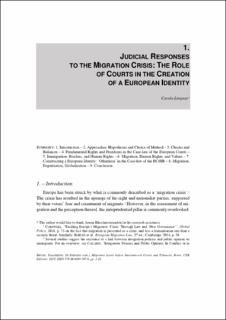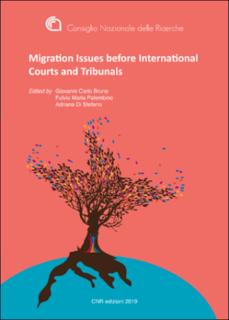| dc.description.abstract | Europe has been struck by what is commonly described as a ‘migration crisis’. The crisis has resulted in the upsurge of far-right and nationalist parties, supported by their voters’ fear and resentment of migrants. However, in the assessment of migration and the perception thereof, the jurisprudential pillar is commonly overlooked. It is in times of crisis that identity changes are most probable, but is this true for jurisprudence too? In taking a foremost human rights-based approach to analyzing the discrimination of migrants, this chapter seeks to advance insight into the role of the European Court of Human Rights (ECtHR) and the Court of Justice of the European Union (ECJ) for the construction of a (perceived) European identity, contrasted to the identity of the ‘others’ from beyond Europe.
The law and the jurisprudence of the European courts are highly effective tools to influence popular and political views on migration. Indeed, current developments suggest that the courts constrain the attribution of rights and, thus, adjust to expectations and perceptions of their constituency. The recognition of the connection between the judicial creation of an ostensible European identity, domestic policy, and public opinion has yet to be explored.
Unlike earlier strategic documents, the EU Global Strategy (2016) treats migration as a challenge and reveals the EU’s internal crisis due to migration inflows. Research has demonstrated that the Global Strategy provides different narratives of migration, e.g. in connection with purported values. It even explicitly emphasises that “remaining true to our values is a matter of law as much as of ethics and identity”. Such value narratives are indicators of the community’s understanding of social relations and can, arguably, influence the European judiciary. Because, if the legal analysis is underpinned by references to policy documents, then the narratives of migration contained therein is likely to be reflected in the courts’ case law.
Not only does case law mirror the values contained in policy documents. Moreover, the increasing referral of the ECtHR to the ECJ’s case law streamlines the human rights standard in Europe. Indeed, the human rights approach of both European courts appears to be largely, if not fully, coherent. What does this signify for judicial treatment of migrants? If the ECtHR increasingly discusses migrants as the ‘others’, this jurisprudence will reflect in the ECJ’s case law, thus amplifying their negative perception. In turn, if the hypothesis is correct that courts’ decisions can influence the public opinion, then the migrants’ situation is further deteriorated. | |

